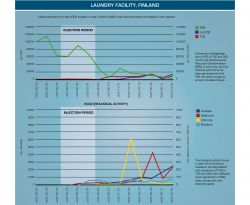A spill of chlorinated solvents, from former now removed PCE storage utilities, caused high levels of soil and groundwater contamination at a laundry facility in southwestern Finland, impacting the groundwater formation on and off site. Previous remedial efforts by means of pump & treat, bio-air sparging and excavation had been conducted from the early 2000’s until 2016 without satisfactory improvements to site conditions. In May 2016, Ejlskov was asked to apply Trap & Treat® CAT 100™ technology for an intensive underground treatment of key problem areas and to place a barrier that would stop contamination migrating into neighboring areas.
No disruption of laundry activities
After conference with client and authorities on cleanup targets and strategy, Ejlskov designed a remedial procedure that would allow laundry activities to continue throughout the entire remediation period. The injection work started in April 2017. During a 5 months period, a full scale in-situ installation was successfully completed across the site, treating identified source areas and preventing further contamination spread downstream.
95% PCE reduction
At this stage, 18 months after injection, monitoring reports show an average reduction of 95% in PCE concentrations throughout treated areas. These are very good achievements so far. All indicators of biological degradation provide clear evidence that ERD (Enhanced Reductive Dechlorination) is ongoing and will continue in the future. Regular groundwater monitoring is planned to continue until 2022 or until obtainment of a No-Further Action letter.
Analysis and remedial design
Ejlskov initiated soil investigations at the site in may 2016. A thorough Remedial Design Characterization (RDC) covering the entire site and part of the off-site downstream area (60-70,000 sqm) was performed. The event included 45 Membrane Interphase Probe (MIP) points, 21 soil core locations and the installation of additional 13 monitoring wells. 255 soil samples and 38 groundwater samples were collected. The RDC defined the actual location, extent and magnitude of the soil contamination. A total of 17,000 kg PCE contamination was assessed to be present on site.
Based on the data collected, Ejlskov designed an exact plan for the in-situ treatment by means of CAT100™/BOS100®, taking different challenging local geology conditions into consideration. Due to its unique composition, CAT 100™ provides treatment of highly impacted areas within a relatively short timeframe. Injection works were started in April 2017 and completed by August 2017, including injections from inside the main building basement (less than 2.2 m clearance). A total of approximately 48,000 kg CAT100™ and 3,800 kg BOS100® were distributed in the subsurface from depths varying from 3-6 m bgl to approximately 7-12 m bgl. 702 injection points were completed over an approximate total surface of 2,200 m2.
The primarily target of the project is to reduce PCE concentrations at site boundary areas from levels exceeding 10,000 μg/l to levels beneath 10 μg/l and to barricade and treat source zone contamination problems, eventually aligning the site with acceptable conditions.


